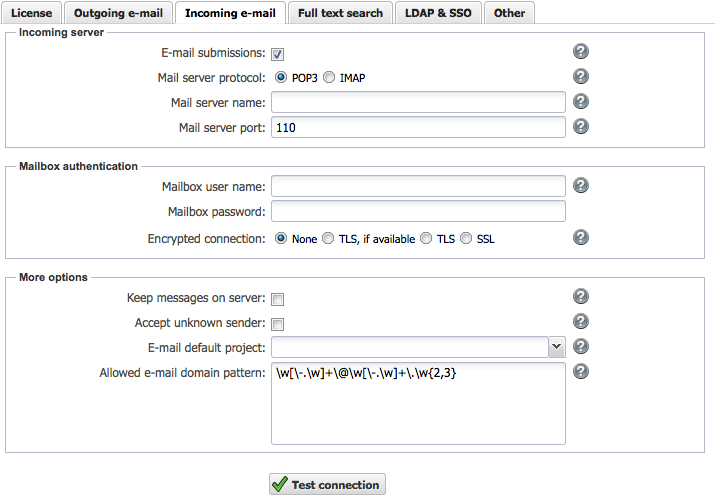Incoming Email Connection#
Allegra can receive emails and create new items from them or add information to existing items. For this purpose, Allegra acts like a standard email client like Outlook or Thunderbird and therefore needs to have a connection with a mailbox on a POP3 or IMAP mail server.
The use of an incoming mailbox is optional, you do not need to configure it.
Mail Server Protocol#
There are two popular email protocols to communicate with a mailbox: POP3 and IMAP. Here you can choose which one you prefer. Your server must support the chosen protocol.

Mail Server Name and Port#
Mailboxes are managed by mail servers. Here you enter the name of the mail server on which the Allegra system mailbox is located.
Usually, you should leave the default port set (110 for POP3 or 143 for IMAP and 995 for POP3 over SSL / TLS and 993 for IMAP over SSL / TLS).
Mailbox Username and Password#
All mailbox servers expect you to authenticate before retrieving emails. Here you enter the username and password.
Warning
Do not use an existing, private account that you also use elsewhere. You could lose emails.
If creating items via email is enabled, this mailbox is regularly checked for new emails. The emails are read and the items are created from the emails. The email subject is assigned to the item title, the email body is assigned to the item description, and all attachments are added to the item as attachments.
Encrypted Connections#
You should use an encrypted connection between your Allegra server and your POP3 or IMAP email server. You can choose between SSL, TLS and TLS if available.
For encrypted connections, you must first import a certificate from your email server into the local keystore of your Allegra server. How this works, is described under Using SSL and TLS Encryption on Email and LDAP Connections.
Email Submissions#
Allegra can be configured to create items or add comments via email. This can be very useful when, for example, customers do not have access to the Allegra system, and can still indirectly submit items there in this way.
You can enable or disable email submissions. You can also decide whether you want to accept email submissions from users who are not registered in the system.
Allegra regularly checks the configured mailbox for new messages and either creates new items in the default project that you must configure here, or adds submissions as comments to existing items, if the subject line is marked with a number and this number can be assigned to an item.
Leave Mails on Server#
Choose this option if you want to keep messages on your mail server, even though your Allegra server has read them. This can be useful if you access the same mailbox with an interactive email client like Thunderbird or Outlook.
Allow Unknown Senders#
Activate this checkbox if you want to allow unknown senders to create items in the Allegra system via email. The email sender’s address is still checked for compliance with the allowed domain patterns but it is no longer necessary that the sender’s email address must be assigned to a user within the Allegra system.
Email Default Workspace#
If email submissions are enabled, there must be a workspace to which the incoming emails can be assigned. This could be a kind of “catch all” workspace, from where the items are regularly transferred to their final workspaces. Usually one or two people monitor this workspace and decide how to proceed.
Each workspace can have its own email inbox configured. In this case a global email inbox does not need to be configured.
Allowed Domain Patterns#
To prevent users from unconfirmed domains (e.g. hotmail.com, gmx.com) from registering, a Perl5 regular expression can be defined so that only email domains that match this expression can register. You will most likely need to change the sample default on the website configuration page.
Example pattern:
[^@\T]@bosch\.com
This example only allows users from the domain “Bosch.com” to register.
Some more examples:
[^@\T]@t-online\.de | [^@\t]@computer\.org
matches all users from domains t-online.de and computer.org. The pattern
\W[-.\W]+\@[-.\W]+\.\W{2,3}
adapts to all email domains without restrictions.
